Legal and Ethics in Nursing: Australian Context and Key Principles
VerifiedAdded on 2023/01/11
|6
|1413
|45
Report
AI Summary
This report provides a detailed examination of legal and ethical considerations within the nursing profession, focusing on the Australian healthcare context. It explores key concepts such as nursing codes of practice/conduct/ethics, the Australian Charter of Health Care Rights, and the critical importance of duty of care. The report also delves into the concept of a “reasonable standard of care,” medical negligence, and the role of the coroner in investigating deaths. The analysis emphasizes the importance of ethical decision-making, patient safety, and the legal responsibilities of nurses in providing high-quality care. The document highlights the interconnectedness of legal and ethical frameworks in ensuring patient well-being and upholding professional standards within the healthcare environment. The report also provides several real world examples to help the reader better understand the concepts covered.
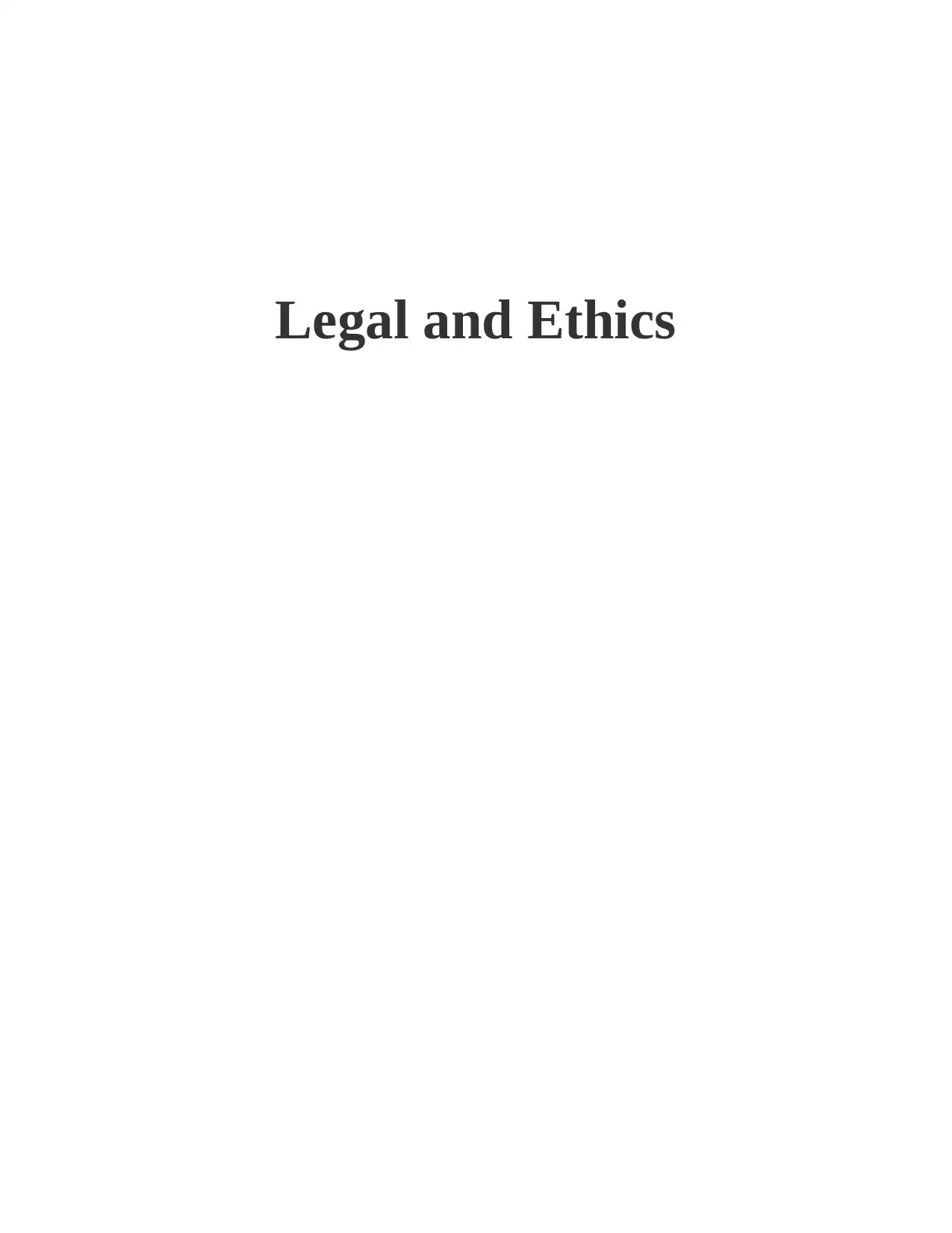
Legal and Ethics
Paraphrase This Document
Need a fresh take? Get an instant paraphrase of this document with our AI Paraphraser
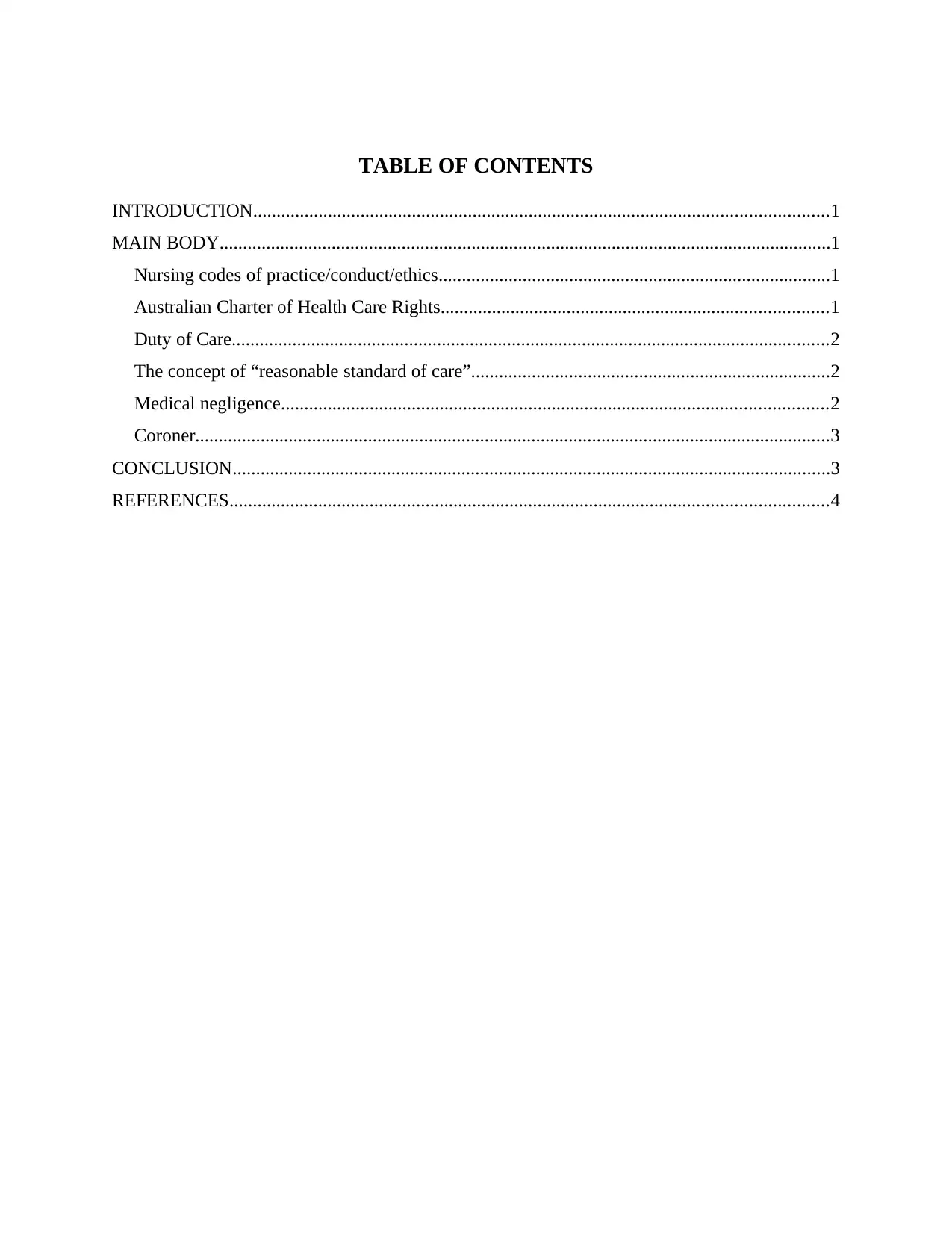
TABLE OF CONTENTS
INTRODUCTION...........................................................................................................................1
MAIN BODY...................................................................................................................................1
Nursing codes of practice/conduct/ethics....................................................................................1
Australian Charter of Health Care Rights...................................................................................1
Duty of Care................................................................................................................................2
The concept of “reasonable standard of care”.............................................................................2
Medical negligence.....................................................................................................................2
Coroner........................................................................................................................................3
CONCLUSION................................................................................................................................3
REFERENCES................................................................................................................................4
INTRODUCTION...........................................................................................................................1
MAIN BODY...................................................................................................................................1
Nursing codes of practice/conduct/ethics....................................................................................1
Australian Charter of Health Care Rights...................................................................................1
Duty of Care................................................................................................................................2
The concept of “reasonable standard of care”.............................................................................2
Medical negligence.....................................................................................................................2
Coroner........................................................................................................................................3
CONCLUSION................................................................................................................................3
REFERENCES................................................................................................................................4
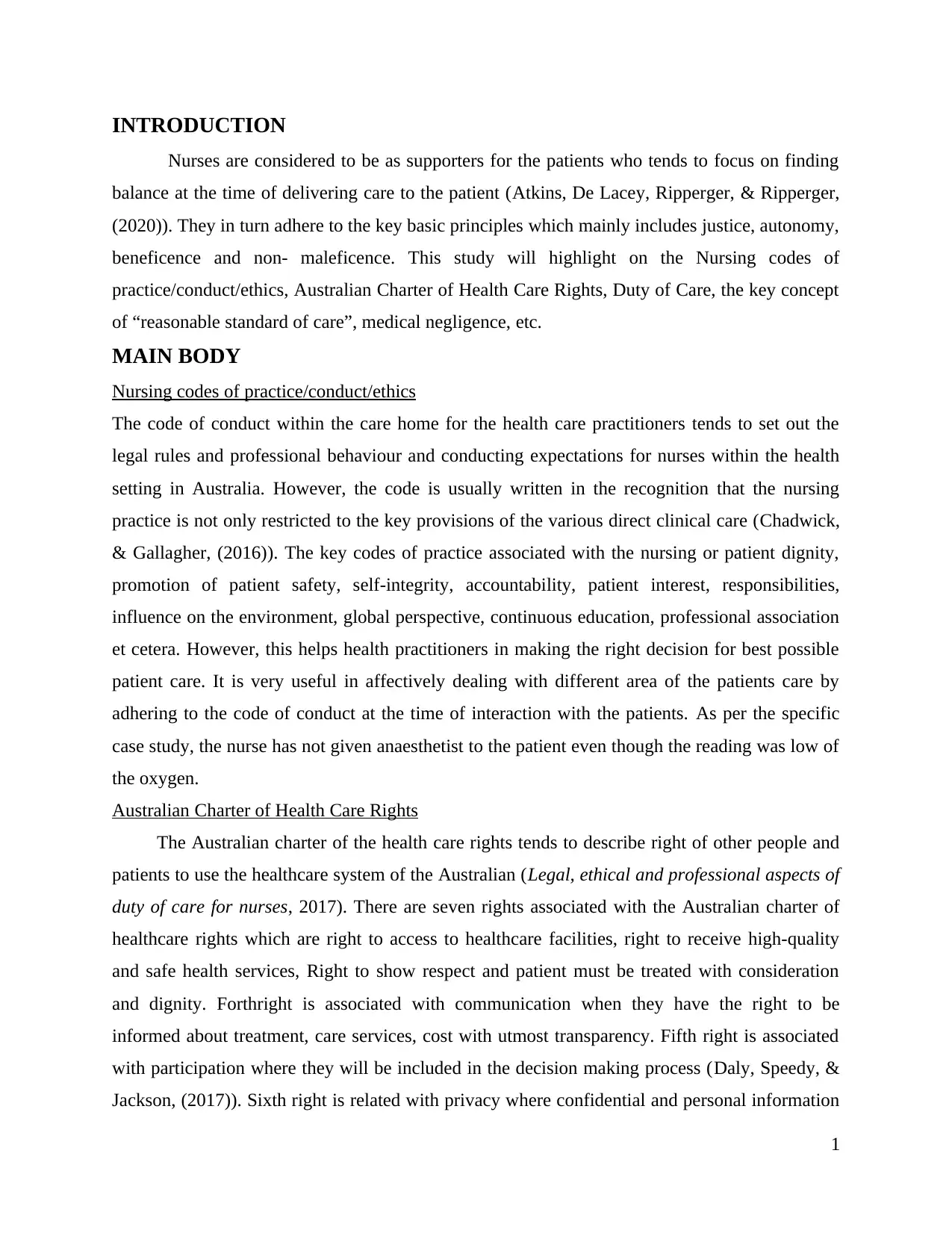
INTRODUCTION
Nurses are considered to be as supporters for the patients who tends to focus on finding
balance at the time of delivering care to the patient (Atkins, De Lacey, Ripperger, & Ripperger,
(2020)). They in turn adhere to the key basic principles which mainly includes justice, autonomy,
beneficence and non- maleficence. This study will highlight on the Nursing codes of
practice/conduct/ethics, Australian Charter of Health Care Rights, Duty of Care, the key concept
of “reasonable standard of care”, medical negligence, etc.
MAIN BODY
Nursing codes of practice/conduct/ethics
The code of conduct within the care home for the health care practitioners tends to set out the
legal rules and professional behaviour and conducting expectations for nurses within the health
setting in Australia. However, the code is usually written in the recognition that the nursing
practice is not only restricted to the key provisions of the various direct clinical care (Chadwick,
& Gallagher, (2016)). The key codes of practice associated with the nursing or patient dignity,
promotion of patient safety, self-integrity, accountability, patient interest, responsibilities,
influence on the environment, global perspective, continuous education, professional association
et cetera. However, this helps health practitioners in making the right decision for best possible
patient care. It is very useful in affectively dealing with different area of the patients care by
adhering to the code of conduct at the time of interaction with the patients. As per the specific
case study, the nurse has not given anaesthetist to the patient even though the reading was low of
the oxygen.
Australian Charter of Health Care Rights
The Australian charter of the health care rights tends to describe right of other people and
patients to use the healthcare system of the Australian (Legal, ethical and professional aspects of
duty of care for nurses, 2017). There are seven rights associated with the Australian charter of
healthcare rights which are right to access to healthcare facilities, right to receive high-quality
and safe health services, Right to show respect and patient must be treated with consideration
and dignity. Forthright is associated with communication when they have the right to be
informed about treatment, care services, cost with utmost transparency. Fifth right is associated
with participation where they will be included in the decision making process (Daly, Speedy, &
Jackson, (2017)). Sixth right is related with privacy where confidential and personal information
1
Nurses are considered to be as supporters for the patients who tends to focus on finding
balance at the time of delivering care to the patient (Atkins, De Lacey, Ripperger, & Ripperger,
(2020)). They in turn adhere to the key basic principles which mainly includes justice, autonomy,
beneficence and non- maleficence. This study will highlight on the Nursing codes of
practice/conduct/ethics, Australian Charter of Health Care Rights, Duty of Care, the key concept
of “reasonable standard of care”, medical negligence, etc.
MAIN BODY
Nursing codes of practice/conduct/ethics
The code of conduct within the care home for the health care practitioners tends to set out the
legal rules and professional behaviour and conducting expectations for nurses within the health
setting in Australia. However, the code is usually written in the recognition that the nursing
practice is not only restricted to the key provisions of the various direct clinical care (Chadwick,
& Gallagher, (2016)). The key codes of practice associated with the nursing or patient dignity,
promotion of patient safety, self-integrity, accountability, patient interest, responsibilities,
influence on the environment, global perspective, continuous education, professional association
et cetera. However, this helps health practitioners in making the right decision for best possible
patient care. It is very useful in affectively dealing with different area of the patients care by
adhering to the code of conduct at the time of interaction with the patients. As per the specific
case study, the nurse has not given anaesthetist to the patient even though the reading was low of
the oxygen.
Australian Charter of Health Care Rights
The Australian charter of the health care rights tends to describe right of other people and
patients to use the healthcare system of the Australian (Legal, ethical and professional aspects of
duty of care for nurses, 2017). There are seven rights associated with the Australian charter of
healthcare rights which are right to access to healthcare facilities, right to receive high-quality
and safe health services, Right to show respect and patient must be treated with consideration
and dignity. Forthright is associated with communication when they have the right to be
informed about treatment, care services, cost with utmost transparency. Fifth right is associated
with participation where they will be included in the decision making process (Daly, Speedy, &
Jackson, (2017)). Sixth right is related with privacy where confidential and personal information
1
⊘ This is a preview!⊘
Do you want full access?
Subscribe today to unlock all pages.

Trusted by 1+ million students worldwide
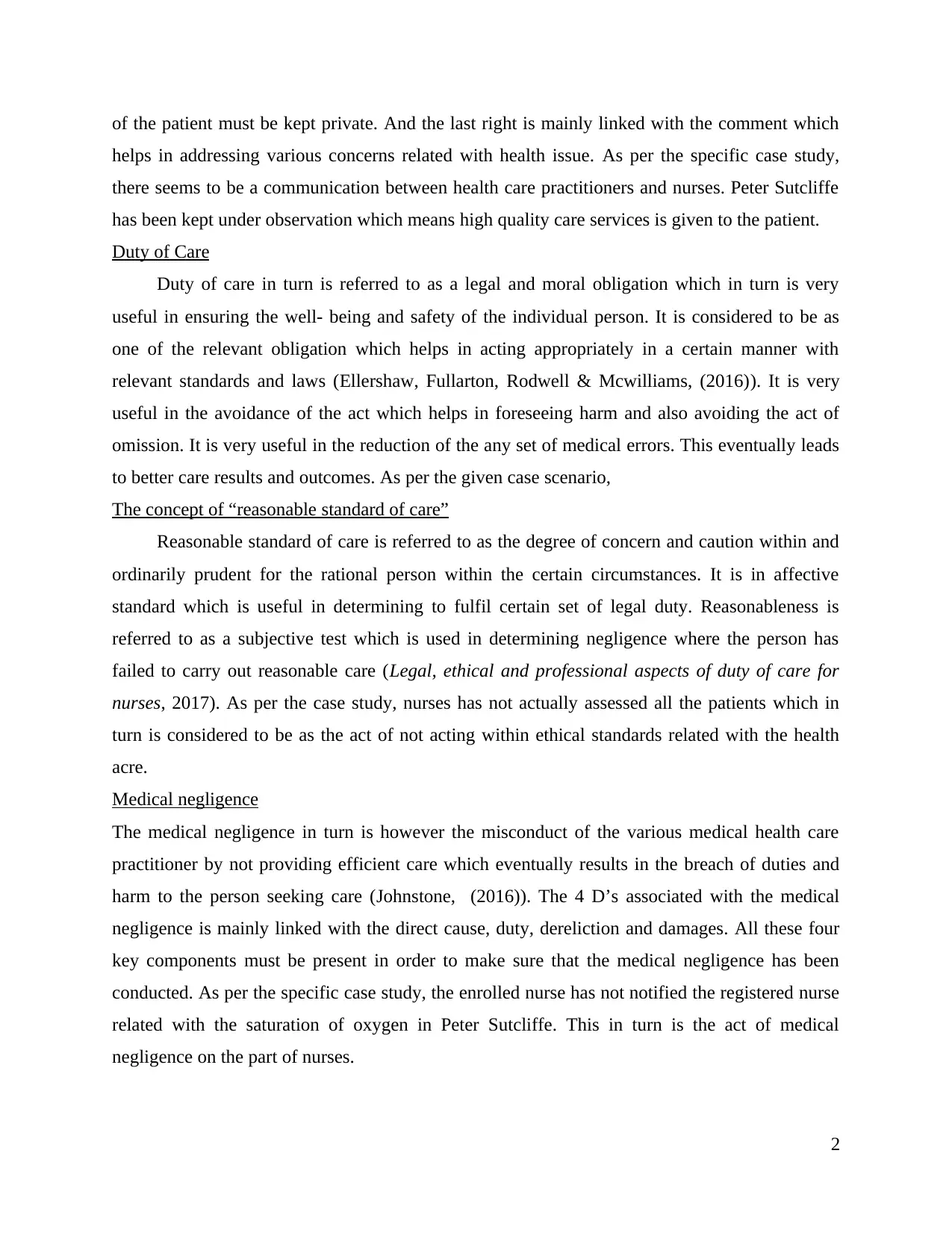
of the patient must be kept private. And the last right is mainly linked with the comment which
helps in addressing various concerns related with health issue. As per the specific case study,
there seems to be a communication between health care practitioners and nurses. Peter Sutcliffe
has been kept under observation which means high quality care services is given to the patient.
Duty of Care
Duty of care in turn is referred to as a legal and moral obligation which in turn is very
useful in ensuring the well- being and safety of the individual person. It is considered to be as
one of the relevant obligation which helps in acting appropriately in a certain manner with
relevant standards and laws (Ellershaw, Fullarton, Rodwell & Mcwilliams, (2016)). It is very
useful in the avoidance of the act which helps in foreseeing harm and also avoiding the act of
omission. It is very useful in the reduction of the any set of medical errors. This eventually leads
to better care results and outcomes. As per the given case scenario,
The concept of “reasonable standard of care”
Reasonable standard of care is referred to as the degree of concern and caution within and
ordinarily prudent for the rational person within the certain circumstances. It is in affective
standard which is useful in determining to fulfil certain set of legal duty. Reasonableness is
referred to as a subjective test which is used in determining negligence where the person has
failed to carry out reasonable care (Legal, ethical and professional aspects of duty of care for
nurses, 2017). As per the case study, nurses has not actually assessed all the patients which in
turn is considered to be as the act of not acting within ethical standards related with the health
acre.
Medical negligence
The medical negligence in turn is however the misconduct of the various medical health care
practitioner by not providing efficient care which eventually results in the breach of duties and
harm to the person seeking care (Johnstone, (2016)). The 4 D’s associated with the medical
negligence is mainly linked with the direct cause, duty, dereliction and damages. All these four
key components must be present in order to make sure that the medical negligence has been
conducted. As per the specific case study, the enrolled nurse has not notified the registered nurse
related with the saturation of oxygen in Peter Sutcliffe. This in turn is the act of medical
negligence on the part of nurses.
2
helps in addressing various concerns related with health issue. As per the specific case study,
there seems to be a communication between health care practitioners and nurses. Peter Sutcliffe
has been kept under observation which means high quality care services is given to the patient.
Duty of Care
Duty of care in turn is referred to as a legal and moral obligation which in turn is very
useful in ensuring the well- being and safety of the individual person. It is considered to be as
one of the relevant obligation which helps in acting appropriately in a certain manner with
relevant standards and laws (Ellershaw, Fullarton, Rodwell & Mcwilliams, (2016)). It is very
useful in the avoidance of the act which helps in foreseeing harm and also avoiding the act of
omission. It is very useful in the reduction of the any set of medical errors. This eventually leads
to better care results and outcomes. As per the given case scenario,
The concept of “reasonable standard of care”
Reasonable standard of care is referred to as the degree of concern and caution within and
ordinarily prudent for the rational person within the certain circumstances. It is in affective
standard which is useful in determining to fulfil certain set of legal duty. Reasonableness is
referred to as a subjective test which is used in determining negligence where the person has
failed to carry out reasonable care (Legal, ethical and professional aspects of duty of care for
nurses, 2017). As per the case study, nurses has not actually assessed all the patients which in
turn is considered to be as the act of not acting within ethical standards related with the health
acre.
Medical negligence
The medical negligence in turn is however the misconduct of the various medical health care
practitioner by not providing efficient care which eventually results in the breach of duties and
harm to the person seeking care (Johnstone, (2016)). The 4 D’s associated with the medical
negligence is mainly linked with the direct cause, duty, dereliction and damages. All these four
key components must be present in order to make sure that the medical negligence has been
conducted. As per the specific case study, the enrolled nurse has not notified the registered nurse
related with the saturation of oxygen in Peter Sutcliffe. This in turn is the act of medical
negligence on the part of nurses.
2
Paraphrase This Document
Need a fresh take? Get an instant paraphrase of this document with our AI Paraphraser
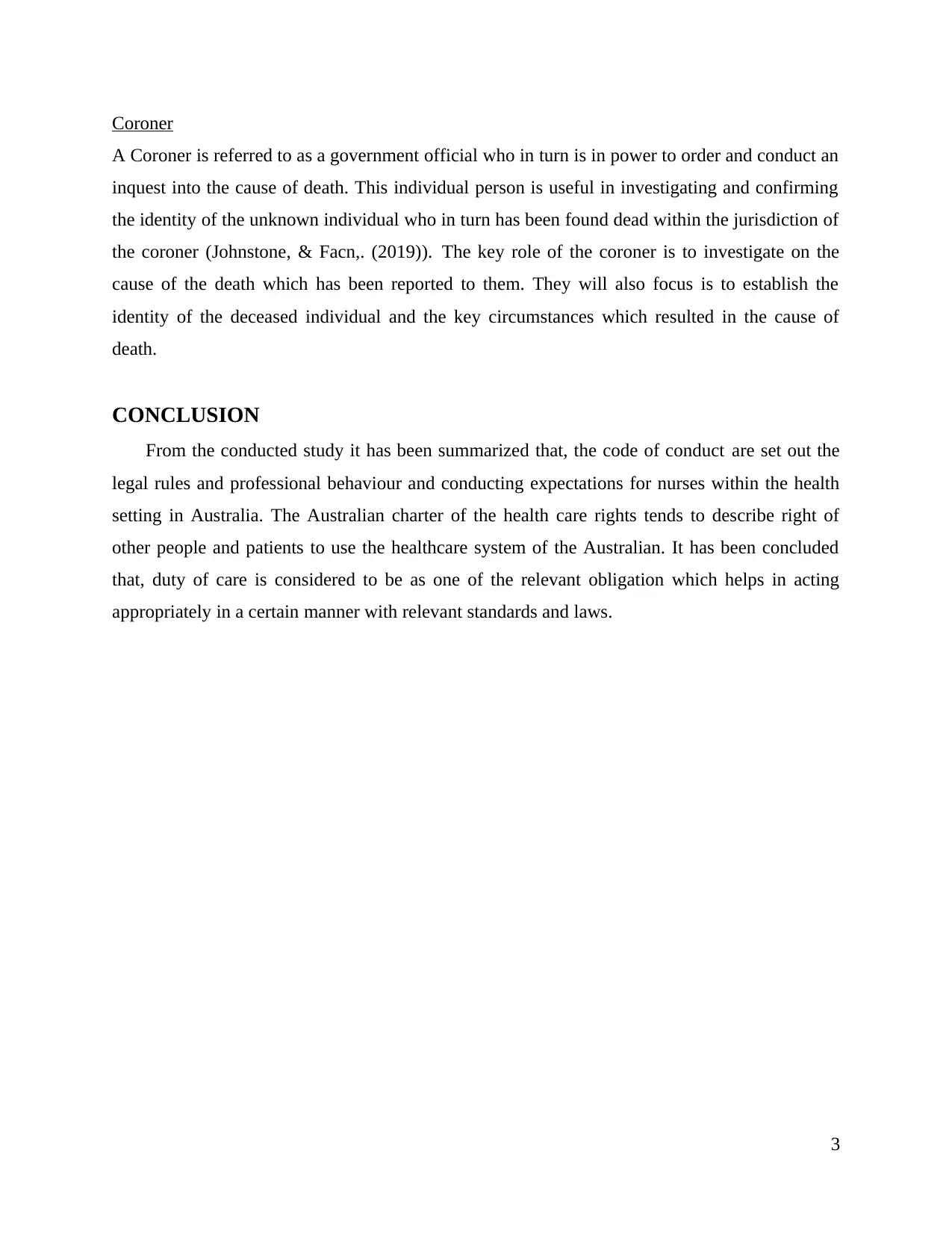
Coroner
A Coroner is referred to as a government official who in turn is in power to order and conduct an
inquest into the cause of death. This individual person is useful in investigating and confirming
the identity of the unknown individual who in turn has been found dead within the jurisdiction of
the coroner (Johnstone, & Facn,. (2019)). The key role of the coroner is to investigate on the
cause of the death which has been reported to them. They will also focus is to establish the
identity of the deceased individual and the key circumstances which resulted in the cause of
death.
CONCLUSION
From the conducted study it has been summarized that, the code of conduct are set out the
legal rules and professional behaviour and conducting expectations for nurses within the health
setting in Australia. The Australian charter of the health care rights tends to describe right of
other people and patients to use the healthcare system of the Australian. It has been concluded
that, duty of care is considered to be as one of the relevant obligation which helps in acting
appropriately in a certain manner with relevant standards and laws.
3
A Coroner is referred to as a government official who in turn is in power to order and conduct an
inquest into the cause of death. This individual person is useful in investigating and confirming
the identity of the unknown individual who in turn has been found dead within the jurisdiction of
the coroner (Johnstone, & Facn,. (2019)). The key role of the coroner is to investigate on the
cause of the death which has been reported to them. They will also focus is to establish the
identity of the deceased individual and the key circumstances which resulted in the cause of
death.
CONCLUSION
From the conducted study it has been summarized that, the code of conduct are set out the
legal rules and professional behaviour and conducting expectations for nurses within the health
setting in Australia. The Australian charter of the health care rights tends to describe right of
other people and patients to use the healthcare system of the Australian. It has been concluded
that, duty of care is considered to be as one of the relevant obligation which helps in acting
appropriately in a certain manner with relevant standards and laws.
3
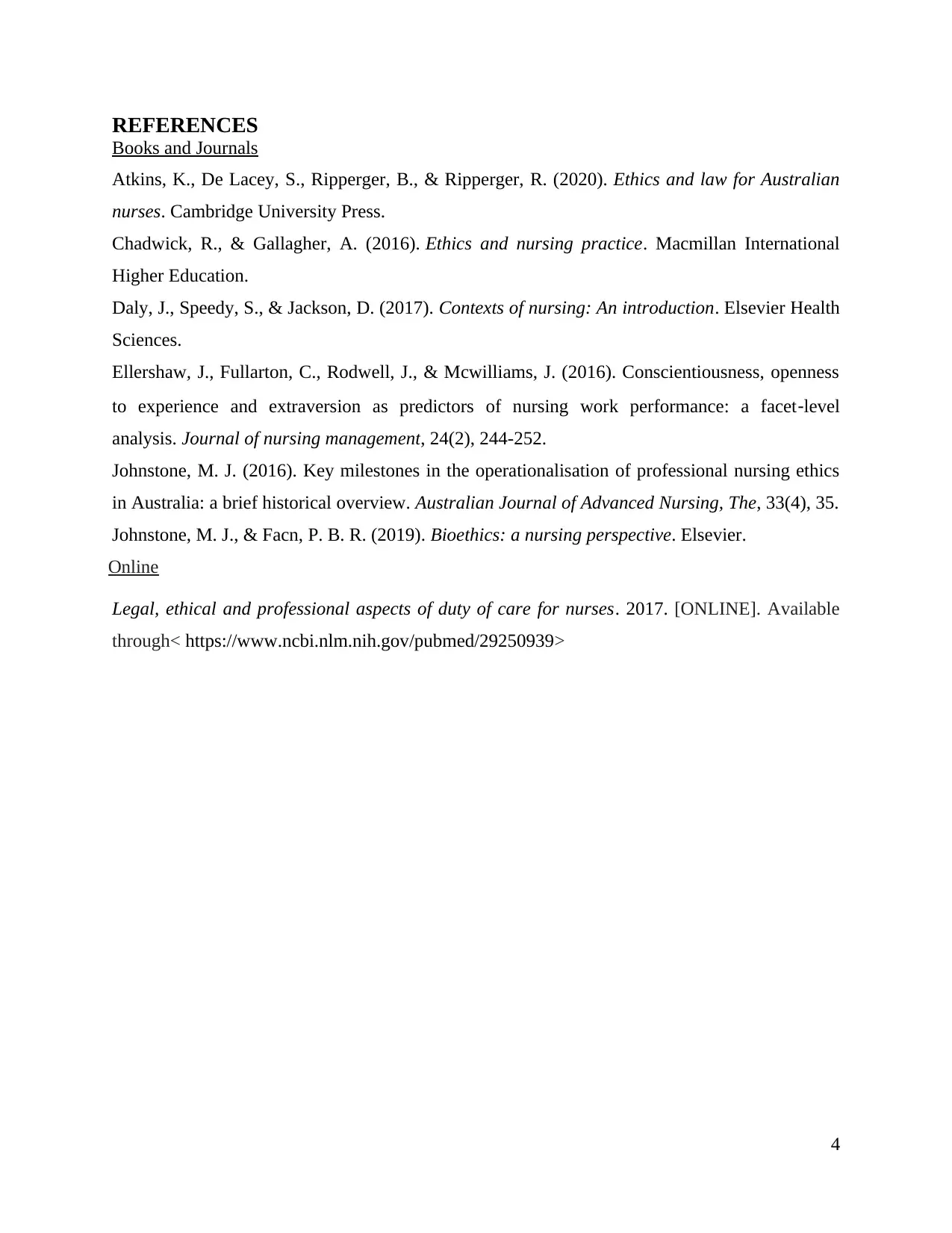
REFERENCES
Books and Journals
Atkins, K., De Lacey, S., Ripperger, B., & Ripperger, R. (2020). Ethics and law for Australian
nurses. Cambridge University Press.
Chadwick, R., & Gallagher, A. (2016). Ethics and nursing practice. Macmillan International
Higher Education.
Daly, J., Speedy, S., & Jackson, D. (2017). Contexts of nursing: An introduction. Elsevier Health
Sciences.
Ellershaw, J., Fullarton, C., Rodwell, J., & Mcwilliams, J. (2016). Conscientiousness, openness
to experience and extraversion as predictors of nursing work performance: a facet‐level
analysis. Journal of nursing management, 24(2), 244-252.
Johnstone, M. J. (2016). Key milestones in the operationalisation of professional nursing ethics
in Australia: a brief historical overview. Australian Journal of Advanced Nursing, The, 33(4), 35.
Johnstone, M. J., & Facn, P. B. R. (2019). Bioethics: a nursing perspective. Elsevier.
Online
Legal, ethical and professional aspects of duty of care for nurses. 2017. [ONLINE]. Available
through< https://www.ncbi.nlm.nih.gov/pubmed/29250939>
4
Books and Journals
Atkins, K., De Lacey, S., Ripperger, B., & Ripperger, R. (2020). Ethics and law for Australian
nurses. Cambridge University Press.
Chadwick, R., & Gallagher, A. (2016). Ethics and nursing practice. Macmillan International
Higher Education.
Daly, J., Speedy, S., & Jackson, D. (2017). Contexts of nursing: An introduction. Elsevier Health
Sciences.
Ellershaw, J., Fullarton, C., Rodwell, J., & Mcwilliams, J. (2016). Conscientiousness, openness
to experience and extraversion as predictors of nursing work performance: a facet‐level
analysis. Journal of nursing management, 24(2), 244-252.
Johnstone, M. J. (2016). Key milestones in the operationalisation of professional nursing ethics
in Australia: a brief historical overview. Australian Journal of Advanced Nursing, The, 33(4), 35.
Johnstone, M. J., & Facn, P. B. R. (2019). Bioethics: a nursing perspective. Elsevier.
Online
Legal, ethical and professional aspects of duty of care for nurses. 2017. [ONLINE]. Available
through< https://www.ncbi.nlm.nih.gov/pubmed/29250939>
4
⊘ This is a preview!⊘
Do you want full access?
Subscribe today to unlock all pages.

Trusted by 1+ million students worldwide
1 out of 6
Related Documents
Your All-in-One AI-Powered Toolkit for Academic Success.
+13062052269
info@desklib.com
Available 24*7 on WhatsApp / Email
![[object Object]](/_next/static/media/star-bottom.7253800d.svg)
Unlock your academic potential
Copyright © 2020–2025 A2Z Services. All Rights Reserved. Developed and managed by ZUCOL.





